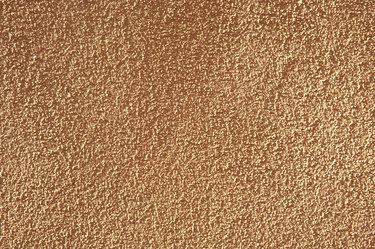
Stucco, a mixture of Portland cement, sand and water, is a masonry building material that has been used to cover the exterior and interior of homes and buildings for many centuries. Stucco is applied wet over a stone or brick wall or onto a wooden or metal lattice, and allowed to dry. When properly applied, cleaned and maintained, a stucco surface can have a life expectancy of up to a 100 years.
Application
Video of the Day
To remain a durable building material, stucco should be applied in three full coats. The first two coats, successively called the "ground" and "scratch" coat, should be each approximately 3/8-inch thick. The third, or "finish" coat can be up to one inch thick. Both drainage points and expansion-contraction joints should be installed into the stucco to prevent moisture build-up and allow for temperature changes; if these are not installed correctly, even the most masterfully-applied stucco will crack.
Video of the Day
Aging
Stucco, in general, will remain stable for 20 years. After that period, the stucco ages and absorbs moisture, and around windows or areas of drainage, the stucco may begin to separate from the wall beneath it. At this point, repairs are required, or by the time the stucco has aged another 10 to 20 years, it will break down entirely.
Repairs
Depending on how the stucco has been affected by moisture and weather, you may need to replace the porous masonry beneath the stucco or patch areas with new stucco mixed with lime to increase its adherence. Because stucco can be difficult to match, painting patched stucco is common; painting also increases the stucco's resistance to moisture and will slow down the aging process.
Preventative Care
Washing your stucco walls periodically will help prevent dirt buildup. Pre-wet the stucco using a garden hose, ensuring that the wall is completely saturated. Then direct the water in a stream from top to bottom to flush away dirt. Allow to dry completely. You should also inspect the stucco walls on a regular basis, paying special attention to areas around windows, doors and drainage pipes to look for cracks or places where the stucco appear swollen. These areas may need patching to moisture-damage repair, and catching these repairs early will ensure that they don't threaten the structural integrity of the stucco as a whole.